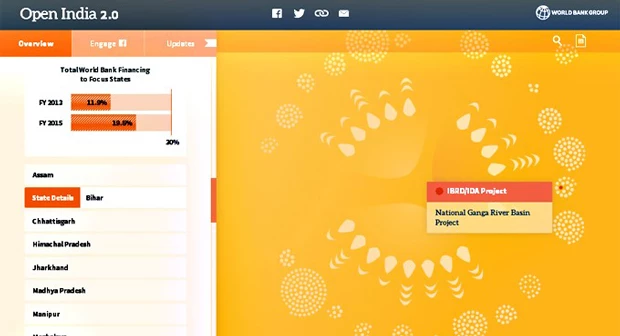Cross posted from the End Poverty in South Asia blog
It has been a season ripe with new ideas and shifts in the open data conversation. At the Cartagena Data Festival in April, the call for a country-led data revolution was loud and clear. Later in June at the 3rd International Open Data Conference in Ottawa there was an emphasis on the use of open data-beyond mere publishing.
Mulling on these takeaways, a logical question to ask may be: what would a country-focused data project that aims to put data to use look like?
Have you tried Open India?
A few months earlier, inspired by the “Digital India” vision, a small but agile team led by the India Team at the World Bank was working on Open India. It’s a live, open platform for engaging with and tracking the why, what, and how of the World Bank Group’s work in India, within the context of the development challenges that India faces. At the heart of this process was data from this vast country and equally important “design thinking” to solve a clear problem.
Here is a glimpse at the journey of this in-house startup. We hope it will add to the evolving data conversation, and help make the case for design to be a part of it. These are our lessons-learned from our journey as World Bank intrapreneurs.
Open India: Take on India’s Development Challenges with the Wo...http://openindia.worldbankgroup.org - The Open India app connects the dots between every public and private sector activity of the World Bank Group in India, against the context of the vast development challenges that the country faces. Use this app to track the World Bank Group’s work in your state and the development issues of your interest, and provide your ideas and feedback.How did we do it? Learn more: http://wrld.bg/TE1ym
Posted by World Bank India on 16 October 2015
Pitch like a startup
India has become one of the fastest growing economies in the last decade, but remains home to a third of the world's poor. Its development challenges are massive: there is a huge infrastructure gap, it is urbanizing at an astonishing pace, and the population is set to cross 1.5 billion. The World Bank Group's Country Partnership Strategy offers an analysis and a plan to tackle these challenges. It covers a portfolio of over $25 billion, and provides a clear results chain to track the strategy’s progress.

With a grounding in data for analysis, implementation, and monitoring of the strategy—and an array of potential users from government to citizens—the strategy had remained a static, text heavy document. This was a ripe opportunity for an “intrapreneural” effort to re-imagine the strategy for a digital world: a strategy that’s alive and interactive, and which citizens can use to track the World Bank Group’s progress. I pitched the idea of an “Open Country Partnership Strategy” to the India team, and after a burst of follow-up discussions, got the green light to move forward and innovate.
Prototype your way forward

We began with a series of short workshops and prototyped our way into making our ideas concrete and gain stakeholder buy-in. We built several low and high-fidelity prototypes to refine our vision for the final product and, in the process, sorted out the most important and intangible needs. As we worked out the prototypes, we identified three core elements: tracking results across all levels of the strategy, developing a narrative for low-income states, and keeping user experience central.

Simultaneously, we were figuring out how to collate and model the data to deliver on our vision. This was an “outside-in” process where datasets were driven by design needs—rather than design trying to fit prescribed datasets. This design-first approach also helped convince stakeholders to release new datasets, importantly, more than 100 sub-national indicators. The concept had now outgrown its initial focus of visualizing just the strategy and was aptly christened “Open India.”
Deliver, learn and evolve
The beta version of Open India was developed from scratch in just four months. Open India was soon delivered to the highest levels in the Indian government, and showcased at the Solutions Café at the World Bank Group and IMF’s 2014 Annual Meetings. It also gathered a warm reception on social media and from aid transparency organizations. Most importantly, the application now gets the most traffic from the country it was intended for: India.
Based on feedback about the beta version, we have recently developed version 2.0, which has deeper social engagement and feedback features. As part of this iteration, we have also expanded the accompanying open datasets to include project-level results. Open India 2.0 was soft-launched and featured as the Bank's data innovation entry at the Cartagena Data Festival.

For specific questions about Open India, send an e-mail to indiaexperts@worldbank.org. Open India is best viewed on any modern browser on your desktop or tablet.



Join the Conversation